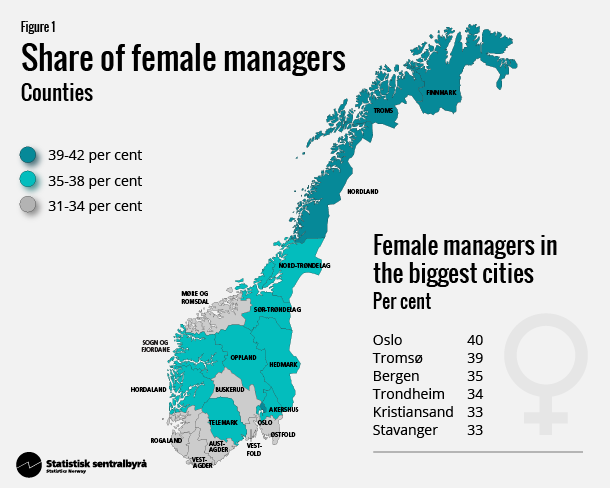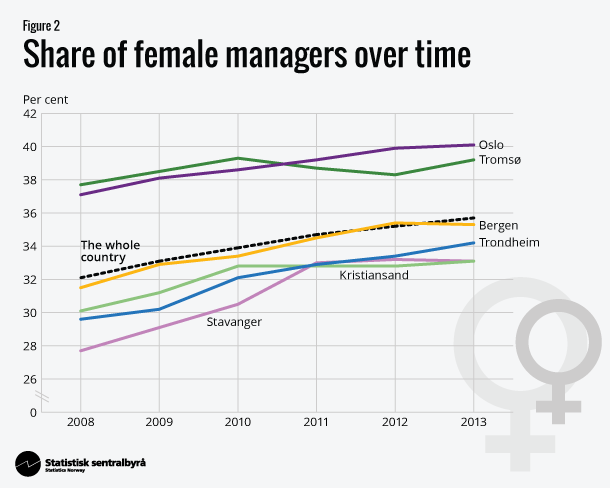Content
Published:
This is an archived release.
More female managers
Statistics Norway’s gender equality indicators for Norwegian municipalities in 2013 show an increase in the proportion of female managers. In all counties, with the exception of Aust-Agder, the proportion of female managers has increased since 2012, and since 2008, the proportion has increased in three out of four municipalities.
| 2012 | 2013 | |
|---|---|---|
| Share of 1-5 years olds in kindergarten (per cent) | 90.1 | 90.0 |
| Share of women among municipal county members (per cent) | 38.2 | 38.2 |
| Share of men with higher education (per cent) | 26.0 | 26.2 |
| Share of women with higher education (per cent) | 31.6 | 32.3 |
| Share of men (20-66 years) in the work force (per cent) | 82.9 | 82.7 |
| Share of women (20-66 years) in the work force (per cent) | 76.8 | 77.1 |
| Average gross income, men (NOK) | 470 500 | 487 800 |
| Average gross income, women (NOK) | 313 100 | 326 400 |
| Share of employed men (20-66 years) working part-time (per cent) | 13.7 | 13.9 |
| Share of employed women (20-66 years) working part-time (per cent) | 34.5 | 34.7 |
| Share of fathers taking the full fathers quota or more (per cent) | 68.1 | 68.5 |
| Level of gender balanced business structure (score) | 0.60 | 0.60 |
| Share of women among employees (20-66 years) in public sector (per cent) | 70.7 | 70.5 |
| Share of women among employees (20-66 years) private sector (per cent) | 36.5 | 36.5 |
| Share of women among leaders (20-66 years) (per cent) | 35.2 | 35.7 |
| Level of gender balance in educational programs in upper secondary school (score | 0.66 | 0.67 |


Municipalities in Oslo, Akershus, northern Norway and Sør-Trøndelag are generally shown to have a high score for the majority of Statistics Norway’s gender equality indicators for 2012, while Southern, Western and South-Eastern Norway generally score lower. This pattern has been prominent ever since Statistics Norway began measuring regional equality.
Most gender equality among managers in the North
The indicator that measures the gender distribution among managers, together with that of fathers with long parental leave, shows the greatest change in the direction of more equality in recent years. Among the counties, Oslo and Finnmark score the highest, while Aust-Agder and Vestfold have the lowest scores.
Also among the municipalities, the greatest gender balance in leadership is found in the northernmost counties. Eleven of the 20 municipalities that score highest on this indicator are located in Nordland, Troms or Finnmark, while half of the 20 municipalities with the lowest scores are located in Møre og Romsdal, Rogaland, Vest-Agder or Aust-Agder. Although managerial positions are becoming more evenly distributed in most municipalities, there are still considerable regional differences. In the most gender equal municipalities, the proportion of men and women in such positions is equal (50/50). No municipalities have a higher proportion of female managers than 50 per cent. However, in the municipalities that score lowest on this indicator, 80 per cent of managers are men.
Stable income disparities
On average, Norwegian women's gross income is 67 per cent of men’s, and the indicator that measures income disparities has changed very little since 2008. The income gap partly reflects the difference in part-time work between men and women, which also has changed little in recent years.
With regard to income disparities, there is, however, a general pattern throughout Northern Norway, especially in Finnmark, of little or no difference between men and women. It can be worth noting that the general level of income among men in the northern municipalities is consistently lower than for men in other municipalities, while women’s income is higher on average.
The most skewed income distribution is found in Southern and Western Norway. All of the 40 municipalities that score lowest on the distribution of income, except two, are found in Møre og Romsdal, Hordaland, Rogaland, Vest-Agder or Aust-Agder. The exceptions are Asker municipality in Akershus and Selje municipality in Sogn og Fjordane.
Many men work part time in Northern Norway
Among the counties, Oslo, Finnmark, Troms and Akershus score highest on the indicator that measures part-time work. Part-time working is generally low among women in these areas. However, in the county of Finnmark, the northernmost county in Norway, many municipalities score high on this indicator due to a larger proportion of men working part time here than in other parts of the country. Of the 25 municipalities with the highest part-time working among men, 5 are found in Finnmark, and 10 in either Finnmark, Troms or Nordland - the three northernmost counties.
High share of fathers with parental leave in Sogn og Fjordane
The municipalities in Sogn og Fjordane stand out in comparison to other municipalities as having a particularly high share of fathers taking the statutory paternity leave or more of the parental leave in connection with childbirth. The proportion of fathers who take long leave is also high in Sør-Trøndelag and Akershus, but in Akershus it has declined since 2012. At the opposite end, we find the lowest scores on this indicator in municipalities in Finnmark, Troms and Nordland. Eleven of the 15 municipalities in the country with the lowest score on paternity are found in these three counties.
Gender equality in the largest cities
All of the six largest towns and cities - Oslo, Kristiansand, Stavanger, Bergen, Trondheim and Tromsø - are among the most equal municipalities. This particularly applies to the indicators measuring differences in education, part-time work, gender balance among managers and in the public and private sectors, as well as the proportion of men and women employed in gender-balanced industries. This reflects a more diverse labour market in the larger municipalities, attracting people with higher education. However, several of the large cities score lower than the national average when it comes to day care and fathers’ use of paternity and parental leave.
Additional information
The indicators of gender equality in municipalities has been published every year since 2008. The indicators are based on available statistics from registers, and measure gender equality in all municipalities and counties, as well as average for the whole country.
